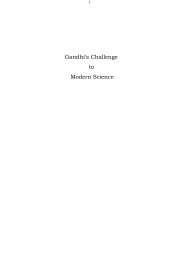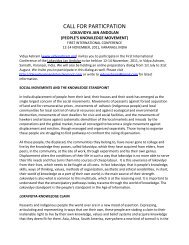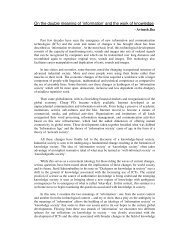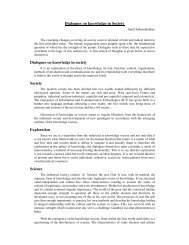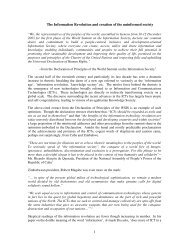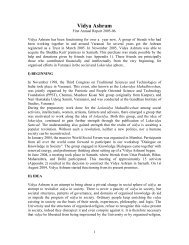Agaria-vidya: A Link in the Philosophy of Emancipation - Vidya Ashram
Agaria-vidya: A Link in the Philosophy of Emancipation - Vidya Ashram
Agaria-vidya: A Link in the Philosophy of Emancipation - Vidya Ashram
You also want an ePaper? Increase the reach of your titles
YUMPU automatically turns print PDFs into web optimized ePapers that Google loves.
<strong>Agaria</strong>-<strong>vidya</strong>:<br />
A <strong>L<strong>in</strong>k</strong> <strong>in</strong> <strong>the</strong> <strong>Philosophy</strong> <strong>of</strong> <strong>Emancipation</strong><br />
Sunil Sahasrabudhey<br />
This article attempts a social-philosophical analysis <strong>of</strong> <strong>the</strong> ferrous science tradition <strong>of</strong> <strong>the</strong><br />
agaria adivasis. The central concern is to <strong>in</strong>vestigate <strong>the</strong> k<strong>in</strong>d <strong>of</strong> social and epistemic<br />
standards and values demanded by such a knowledge system and by <strong>the</strong> knowledge tradition<br />
extant among various components <strong>of</strong> <strong>the</strong> swadeshi samaj which are completely different from<br />
<strong>the</strong> modern science. Attempt is also made to see how such traditions <strong>of</strong> knowledge can<br />
become sources <strong>of</strong> strengths for <strong>the</strong> society and how <strong>the</strong>y can play <strong>the</strong>ir role <strong>in</strong> help<strong>in</strong>g <strong>the</strong><br />
people oriented philosophies to assume social power.<br />
1. The <strong>Agaria</strong><br />
The agarias <strong>of</strong> Chhattisgarh have preserved <strong>the</strong> ferrous technology tradition <strong>of</strong> this<br />
civilization. These people who make pure iron by smelt<strong>in</strong>g <strong>the</strong> ord<strong>in</strong>ary iron ore <strong>in</strong> very small<br />
furnaces located <strong>in</strong> <strong>the</strong>ir house-premises and are <strong>the</strong> preservers <strong>of</strong> such high art and science<br />
are just about <strong>the</strong> poorest <strong>in</strong> this country and untouchable <strong>in</strong> <strong>the</strong> larger society whose part<br />
<strong>the</strong>y are. It is difficult to f<strong>in</strong>d a more tell<strong>in</strong>g example <strong>of</strong> how this great source <strong>of</strong> strength <strong>in</strong><br />
society has been kept <strong>in</strong> a state <strong>of</strong> choiceless, powerless existence.<br />
We got an opportunity to meet <strong>the</strong> agaria <strong>in</strong> 1990. Then we were <strong>in</strong>vestigat<strong>in</strong>g <strong>the</strong> idea <strong>of</strong><br />
liv<strong>in</strong>g traditions as a start<strong>in</strong>g po<strong>in</strong>t for open<strong>in</strong>g pathways <strong>of</strong> thought and action which may<br />
lead to a society free <strong>of</strong> exploitation. The concept <strong>of</strong> non-political power was already born <strong>in</strong><br />
<strong>the</strong> context <strong>of</strong> <strong>the</strong> farmers’ movement, fur<strong>the</strong>r, attempts were live for realiz<strong>in</strong>g as its basis, at<br />
least <strong>in</strong> <strong>the</strong>ory, those forms <strong>of</strong> knowledge and social power which were <strong>in</strong>dependent <strong>of</strong><br />
modern science and <strong>the</strong> modern state and had <strong>the</strong> capacity to challenge <strong>the</strong>se <strong>in</strong>struments <strong>of</strong><br />
rule by man over man. It is at such time that PPST got a project for work on <strong>the</strong> live ferrous<br />
tradition. This project brought forth a variety <strong>of</strong> <strong>in</strong>terest<strong>in</strong>g po<strong>in</strong>ts about this <strong>in</strong>dustrial<br />
tradition and later <strong>the</strong> context <strong>of</strong> <strong>the</strong> First Congress on Traditional Sciences and Technologies<br />
<strong>of</strong> India held at I.I.T. Bombay <strong>in</strong> 1993 provided an opportunity to organize this work from<br />
Varanasi.<br />
Indian steel <strong>in</strong>dustry has a long history. Archaeo-metallurgy is a well def<strong>in</strong>ed subject <strong>in</strong> <strong>the</strong><br />
universities. Steel mak<strong>in</strong>g has touched ra<strong>the</strong>r high po<strong>in</strong>ts <strong>in</strong> this land. The ‘Damascus’ swords<br />
were made from Indian steel. It is this tradition which we see liv<strong>in</strong>g among <strong>the</strong> agaria. Far<br />
from <strong>the</strong> cities, towns and <strong>the</strong> roads, deep <strong>in</strong>to <strong>the</strong> forest and mounta<strong>in</strong> ranges where <strong>the</strong><br />
agents <strong>of</strong> <strong>the</strong> government f<strong>in</strong>d it too troublesome to go, <strong>the</strong>re are villages <strong>in</strong> <strong>the</strong> district <strong>of</strong><br />
Sarguja where <strong>in</strong> a number <strong>of</strong> houses one can f<strong>in</strong>d <strong>the</strong> red glow <strong>in</strong> <strong>the</strong> small furnaces; iron-
smelt<strong>in</strong>g goes on here. The furnace is just about a yard <strong>in</strong> height and may be a foot and a half<br />
<strong>the</strong> measure <strong>of</strong> its outer diameter. The cyl<strong>in</strong>drical contraption is somewhat wider at <strong>the</strong> base<br />
and narrow at <strong>the</strong> top with a vertical hole <strong>in</strong> <strong>the</strong> centre whose diameter is about 8-10 <strong>in</strong>ches. It<br />
is made <strong>of</strong> earth mixed with a little rice husk, <strong>the</strong> central hole is from where <strong>the</strong> iron ore and<br />
<strong>the</strong> charcoal are charged from above. The ore is usually found near <strong>the</strong> mounta<strong>in</strong>s and <strong>the</strong><br />
rivers. The charcoal is made by partially burn<strong>in</strong>g <strong>the</strong> picked up twigs and branches <strong>of</strong> trees <strong>in</strong><br />
<strong>the</strong> forest. The furnace has two horizontal holes at <strong>the</strong> bottom at about 100 degree from each<br />
o<strong>the</strong>r meet<strong>in</strong>g <strong>the</strong> vertical hole at <strong>the</strong> lowest end. One <strong>of</strong> <strong>the</strong>se holes is for <strong>the</strong> slag to flow out<br />
and <strong>the</strong> o<strong>the</strong>r is used for supply<strong>in</strong>g air to <strong>the</strong> high temperature zone us<strong>in</strong>g a bamboo with a<br />
longitud<strong>in</strong>al hole and a lea<strong>the</strong>r contraption for bellows. After a process <strong>of</strong> about 3 hours <strong>the</strong><br />
agaria eng<strong>in</strong>eer opens <strong>the</strong> air supply hole and pulls out a red iron bloom <strong>of</strong> about 3-4<br />
kilogram weight by a long pair <strong>of</strong> tongs. The iron bloom is <strong>the</strong>n squeezed by heavy<br />
hammer<strong>in</strong>g. This is almost 100% pure wrought iron, malleable, ductile etc. It is not pig iron,<br />
<strong>the</strong> carbon content is somewhere around 0.03%. This simple look<strong>in</strong>g process <strong>in</strong> fact seems to<br />
be woven by a balanced coord<strong>in</strong>ation <strong>of</strong> some <strong>of</strong> <strong>the</strong> very f<strong>in</strong>e processes. Attempts to<br />
replicate <strong>in</strong> <strong>the</strong> University campuses are yet to deliver. The agaria seems to be a great master.<br />
You may change <strong>the</strong> charcoal, <strong>the</strong> source <strong>of</strong> <strong>the</strong> ore, <strong>the</strong> place or climate and <strong>the</strong> agraia<br />
eng<strong>in</strong>eer takes one or two experiments to settle on <strong>the</strong> new comb<strong>in</strong>ation <strong>of</strong> different factors to<br />
deliver <strong>the</strong> sponge aga<strong>in</strong>. If you see him through <strong>the</strong> entire exercise you will be surprised to<br />
f<strong>in</strong>d that each time he does an errorless job <strong>of</strong> smelt<strong>in</strong>g without use <strong>of</strong> any mach<strong>in</strong>e, without<br />
measur<strong>in</strong>g <strong>the</strong> rate <strong>of</strong> supply <strong>of</strong> air, <strong>the</strong> temperature, <strong>the</strong> rate <strong>of</strong> charge <strong>of</strong> ore and charcoal<br />
from above and without look<strong>in</strong>g at <strong>the</strong> watch even ones.<br />
The details available <strong>in</strong> books tell us that this wrought iron was taken <strong>in</strong> small pieces and<br />
fired for 48 hours <strong>in</strong> small crucibles mixed with some organic matter, to produce high carbon<br />
steel known as wootz. Mak<strong>in</strong>g <strong>of</strong> wootz is considered <strong>the</strong> highest po<strong>in</strong>t <strong>of</strong> this tradition <strong>of</strong><br />
ferrous technology. There must be agaria workmen even now who know how to make wootz,<br />
who may even be do<strong>in</strong>g it. What appears to an educated eye just a technique or a liv<strong>in</strong>g<br />
practice is <strong>in</strong> fact an activity which is <strong>in</strong>tegral to <strong>the</strong> history, geography, belief system, culture<br />
and economy <strong>of</strong> <strong>the</strong> society <strong>of</strong> <strong>the</strong> agaria and it is perhaps <strong>in</strong> this unity that it f<strong>in</strong>ds <strong>the</strong> basis<br />
<strong>of</strong> survival <strong>in</strong> spite <strong>of</strong> <strong>the</strong> very heavy odds.<br />
The studies on <strong>the</strong> agaria tell us that iron has a central role <strong>in</strong> <strong>the</strong> life <strong>of</strong> <strong>the</strong> <strong>in</strong>dividual and<br />
<strong>the</strong> community. Iron has critical and important ritualistic role <strong>in</strong> every significant event from<br />
birth through marriage etc. to death. Their mythology and <strong>the</strong> actual real life economic<br />
activities all have iron at <strong>the</strong>ir centre. An understand<strong>in</strong>g <strong>of</strong> such a context is necessary to<br />
understand <strong>the</strong> relation between knowledge and society. We would like our <strong>in</strong>vestigation to<br />
address questions like what is <strong>the</strong> form <strong>of</strong> such knowledge, what can be its role <strong>in</strong> <strong>the</strong> social<br />
dynamic, whe<strong>the</strong>r it can become a source <strong>of</strong> strength for <strong>the</strong> agaria community and/or for <strong>the</strong><br />
larger society, does it entail ontological possibilities not admitted <strong>in</strong> modern science, does<br />
adivasi-<strong>vidya</strong> constitute a just and emancipative form <strong>of</strong> knowledge and does loka<strong>vidya</strong> po<strong>in</strong>t<br />
<strong>of</strong> view provide sufficient basis to address <strong>the</strong>se questions However, before we get on to<br />
<strong>the</strong>se questions it may be useful to have a look at <strong>the</strong> relationship that <strong>the</strong> agaria has with <strong>the</strong><br />
larger society and <strong>the</strong> modern state.
The chief sources <strong>of</strong> livelihood <strong>of</strong> <strong>the</strong> agarias are agriculture, repairs and ma<strong>in</strong>tenance <strong>of</strong><br />
agricultural implements, wage labour, smelt<strong>in</strong>g and fabrication <strong>of</strong> iron implements, live stock<br />
(goat, pig, hen etc.) and collection <strong>of</strong> forest produce <strong>in</strong>clud<strong>in</strong>g hunt<strong>in</strong>g <strong>of</strong> small animals etc.<br />
The total <strong>in</strong>come is so small that no aspect <strong>of</strong> life is even passably well attended. They live <strong>in</strong><br />
clusters <strong>of</strong> houses rang<strong>in</strong>g from 2-3 to 10-12 at a place on <strong>the</strong> outskirts <strong>of</strong> villages. Most<br />
villages, which <strong>in</strong>cludes both adivasis and non-adivasis, treat <strong>the</strong>m as untouchable. The<br />
expert among <strong>the</strong>m do get some recognition <strong>in</strong> <strong>the</strong> local society and <strong>the</strong>se specialists too<br />
ord<strong>in</strong>arily do not work for wages on o<strong>the</strong>r’s premises. Their activity <strong>of</strong> iron smelt<strong>in</strong>g may be<br />
shown as violat<strong>in</strong>g <strong>the</strong> M<strong>in</strong>erals Act and <strong>the</strong> Forest Act which gives space to <strong>the</strong> local forest<br />
guard and <strong>the</strong> policemen to throw a scare <strong>in</strong>to <strong>the</strong>m and obta<strong>in</strong> small favours. After<br />
<strong>in</strong>dependence <strong>the</strong> government organised campaigns to stop local iron smelt<strong>in</strong>g. In <strong>the</strong>se<br />
campaigns <strong>the</strong> agaria have suffered also from police action, imprisonment etc. The agaria<br />
are so poor and weak that all <strong>the</strong>se have thrown a great scare <strong>in</strong>to <strong>the</strong>m. When we had got<br />
out <strong>in</strong>to <strong>the</strong> open <strong>in</strong> search <strong>of</strong> <strong>the</strong>se furnaces, <strong>the</strong> stock reply we got was that all this had<br />
ended long ago. Those who were <strong>the</strong>mselves operat<strong>in</strong>g <strong>the</strong> furnaces, also gave this reply.<br />
Because <strong>of</strong> untouchability <strong>the</strong>y are unable to derive any strength from <strong>the</strong> larger adivasi<br />
society too. Those from <strong>the</strong> modern world presume that even if smelt<strong>in</strong>g furnaces are be<strong>in</strong>g<br />
worked at some places <strong>the</strong>y are bound to die out soon, it be<strong>in</strong>g only a matter <strong>of</strong> time.<br />
Archaeologists, Metallurgists and Pr<strong>of</strong>essors <strong>of</strong> Universities look at <strong>the</strong> whole process as<br />
some liv<strong>in</strong>g remnant <strong>of</strong> a great tradition but fail to acknowledge <strong>the</strong> scientific status <strong>of</strong> such<br />
experts and do not give <strong>the</strong>m a status higher than that <strong>of</strong> a skilled worker. These people th<strong>in</strong>k<br />
that <strong>the</strong>y know more about iron mak<strong>in</strong>g than <strong>the</strong> agaria, perhaps because <strong>the</strong>y can write about<br />
it but <strong>the</strong> agaria cannot. Even such political leaders who have no vested <strong>in</strong>terest are also<br />
guided by <strong>the</strong> standpo<strong>in</strong>t <strong>of</strong> <strong>the</strong> University Science. Social activists work<strong>in</strong>g for <strong>the</strong><br />
transformation <strong>of</strong> society with <strong>the</strong> <strong>in</strong>tervention <strong>of</strong> modern technologies also do not see <strong>the</strong><br />
knowledge <strong>of</strong> <strong>the</strong> agaria as<br />
a source <strong>of</strong> strength <strong>in</strong> society but only as a remnant <strong>of</strong> a once valued tradition which is<br />
bound to die out with passage <strong>of</strong> time. Thus here too <strong>the</strong>re is no hope. It is only <strong>the</strong><br />
standpo<strong>in</strong>t <strong>of</strong> loka<strong>vidya</strong> <strong>in</strong>spired by Gandhi’s philosophy which provides <strong>the</strong> start<strong>in</strong>g po<strong>in</strong>t for<br />
such analysis and <strong>in</strong>vestigation which may break fresh ground for <strong>in</strong>fusion <strong>of</strong> a new dynamic<br />
<strong>in</strong> society.<br />
2. Form <strong>of</strong> Knowledge<br />
Pr<strong>of</strong>essors <strong>in</strong> <strong>the</strong> Universities are not ready to grant it <strong>the</strong> status <strong>of</strong> knowledge. S<strong>in</strong>ce this is<br />
<strong>the</strong> value <strong>of</strong> rul<strong>in</strong>g classes and has widespread existence <strong>in</strong> society, <strong>the</strong> knowledge <strong>of</strong> <strong>the</strong><br />
agaria does not get <strong>the</strong> respect it deserves. The loka<strong>vidya</strong> standpo<strong>in</strong>t recognizes <strong>the</strong><br />
systematic falsehood present <strong>in</strong> such a view and with its help one may attempt to uncover <strong>the</strong><br />
reality <strong>of</strong> <strong>the</strong> knowledge <strong>of</strong> <strong>the</strong> agaria. This section tries to underl<strong>in</strong>e <strong>the</strong> possible salient<br />
features <strong>of</strong> such an attempt.<br />
Structure <strong>of</strong> a system <strong>of</strong> knowledge can be understood through <strong>the</strong> <strong>in</strong>gra<strong>in</strong>ed values, <strong>the</strong> body<br />
<strong>of</strong> knowledge and ontological commitments. This understand<strong>in</strong>g is <strong>the</strong> result <strong>of</strong> comb<strong>in</strong><strong>in</strong>g
loka<strong>vidya</strong> standpo<strong>in</strong>t with philosophical analyses <strong>of</strong> modern sciences and it is presented here<br />
not as some ultimate truth or understand<strong>in</strong>g but as an analytical tool necessary for <strong>the</strong>oretical<br />
activity today.<br />
(a) Value:<br />
An agaria family (2 bro<strong>the</strong>rs, Ram Saputtar & Ram Sundar and <strong>the</strong>ir children) from<br />
village Pendari, Wardruffnagar, Sarguja, Chhattisgarh (<strong>the</strong>n Madhya Pradesh)<br />
performed a successful demonstration <strong>of</strong> <strong>the</strong>ir iron smelt<strong>in</strong>g method <strong>in</strong> Swadeshi<br />
Vigyan Karyashala organised <strong>in</strong> October 1993 at Gandhian Institute <strong>of</strong> Studies,<br />
Varanasi. Thousands <strong>of</strong> people saw two furnaces operated for three days. This was <strong>the</strong><br />
first demonstration ever <strong>of</strong> <strong>the</strong> swadeshi iron smelt<strong>in</strong>g <strong>in</strong> any modern <strong>in</strong>stitution <strong>of</strong><br />
learn<strong>in</strong>g. The chief expert Sri Ram Sunder sacrificed a cock before start<strong>in</strong>g <strong>the</strong> work<br />
wear<strong>in</strong>g a brand new dhoti. He was not ready to compromise on <strong>the</strong>se preconditions.<br />
S<strong>in</strong>ce a cock was sacrificed <strong>in</strong> an <strong>in</strong>stitution runn<strong>in</strong>g <strong>in</strong> <strong>the</strong> name <strong>of</strong> Gandhi, it gave<br />
rise to considerable debate before and after <strong>the</strong> event.<br />
Dur<strong>in</strong>g our loka<strong>vidya</strong> work we have met all k<strong>in</strong>ds <strong>of</strong> experts who are not ready to<br />
separate <strong>the</strong>ir faith and values from <strong>the</strong> knowledge system <strong>the</strong>y master. Social<br />
historians have <strong>of</strong>ten seen it as superstition. If at all a rationale is granted it is only as<br />
fulfill<strong>in</strong>g a need <strong>in</strong> his social security. Loka<strong>vidya</strong> standpo<strong>in</strong>t argues that <strong>the</strong>se methods<br />
<strong>of</strong> understand<strong>in</strong>g <strong>the</strong> specialization and custom <strong>in</strong> larger society are extremely weak<br />
and are noth<strong>in</strong>g but an ugly and false expression <strong>of</strong> <strong>the</strong> secular values <strong>of</strong> modern<br />
science.<br />
Knowledge is always value-laden. Social values which provide <strong>the</strong> concrete context<br />
<strong>of</strong> <strong>the</strong> development <strong>of</strong> any stream <strong>of</strong> knowledge are also its <strong>in</strong>ternal values. Any<br />
spontaneous, self-propell<strong>in</strong>g and autonomous activity must have <strong>the</strong> same external<br />
and <strong>in</strong>ternal values. Just as human be<strong>in</strong>gs are <strong>in</strong> a constant state <strong>of</strong> <strong>in</strong>teraction with<br />
<strong>the</strong>ir environment and cannot be conceived <strong>in</strong>dependent <strong>of</strong> <strong>the</strong>ir environment (<strong>in</strong> fact<br />
<strong>the</strong> basic elements <strong>of</strong> <strong>the</strong> two are perhaps fundamentally not dist<strong>in</strong>guishable) similarly<br />
knowledge systems are not separable from <strong>the</strong> values <strong>the</strong>y embody and are embedded<br />
<strong>in</strong> and if we do this we draw only a false picture <strong>of</strong> <strong>the</strong> knowledge system. It is this<br />
picture, which gives birth to <strong>the</strong> dream <strong>of</strong> completely transform<strong>in</strong>g knowledge <strong>in</strong>to<br />
mach<strong>in</strong>e.<br />
The agaria himself does not see his smelt<strong>in</strong>g capacity as separable from his society,<br />
traditions, faith and values. If we completely disregard agaria’s view <strong>of</strong> his own<br />
knowledge while form<strong>in</strong>g a view on his knowledge <strong>the</strong>n we are bound to depart away<br />
from truth and <strong>the</strong> error would be greatly compounded if we th<strong>in</strong>k that his view <strong>of</strong> his<br />
knowledge is <strong>in</strong>correct. Don’t we all accept that <strong>the</strong> agaria is nei<strong>the</strong>r a mach<strong>in</strong>e nor a<br />
remnant but a liv<strong>in</strong>g human be<strong>in</strong>g.<br />
(b)<br />
Body <strong>of</strong> knowledge:
Autonomous streams <strong>of</strong> knowledge have autonomous view po<strong>in</strong>ts on <strong>the</strong> question <strong>of</strong><br />
knowledge. Who knows through what <strong>the</strong>oretical categories are understood <strong>the</strong> ore<br />
and its purity, charcoal from <strong>the</strong> wood <strong>of</strong> different trees, ceramic properties <strong>of</strong><br />
furnaces, quality <strong>of</strong> product, process temperature, rate <strong>of</strong> operation <strong>of</strong> bellows etc.<br />
The agaria ought to know how he does it. There is no reason to believe that<br />
categories and objects <strong>of</strong> knowledge assumed and prescribed by modern science<br />
should be acceptable <strong>in</strong> o<strong>the</strong>r knowledge systems too.<br />
Everybody knows that <strong>the</strong> <strong>the</strong>oretical categories <strong>of</strong> modern medical science are<br />
completely different from those <strong>in</strong> ayurveda. Just as results <strong>of</strong> pathological tests do<br />
not make sense to a vaidya similarly doctors <strong>of</strong> modern medic<strong>in</strong>e do not understand<br />
<strong>the</strong> language <strong>of</strong> Vayu-pitta-cuf. Similar is <strong>the</strong> situation perhaps between a pr<strong>of</strong>essor <strong>of</strong><br />
metallurgy and <strong>the</strong> agaria.<br />
Ano<strong>the</strong>r question <strong>of</strong> great importance is about <strong>the</strong> relation between technical<br />
knowledge and society. It somebody says that <strong>the</strong> agaria is do<strong>in</strong>g iron smelt<strong>in</strong>g for 2-<br />
3 millennia and dur<strong>in</strong>g this period this community has developed a special<br />
relationship with iron, this relation be<strong>in</strong>g part <strong>of</strong> <strong>the</strong> agaria’s knowledge <strong>of</strong> iron<br />
works and that any group or community or even <strong>in</strong>dividual cannot develop this<br />
understand<strong>in</strong>g <strong>in</strong> a few years, <strong>the</strong>n how are we to respond to this. Will this<br />
understand<strong>in</strong>g be considered sufficiently human or as one limit<strong>in</strong>g human capacity<br />
and activity to racial specificity Or will this understand<strong>in</strong>g open new broad ways for<br />
just human activity through an understand<strong>in</strong>g <strong>of</strong> racial autonomy and dynamic The<br />
answer to <strong>the</strong>se questions is related to whe<strong>the</strong>r a body <strong>of</strong> knowledge has some simple<br />
and absolute existence or whe<strong>the</strong>r it takes shape accord<strong>in</strong>g to different societies and<br />
streams <strong>of</strong> knowledge prevalent among <strong>the</strong>m.<br />
(c) Logic:<br />
The logic <strong>of</strong> <strong>the</strong> knowledge <strong>of</strong> <strong>the</strong> agaria is certa<strong>in</strong>ly different. We have seen Ram<br />
Sundar at <strong>the</strong> smelt<strong>in</strong>g operations. We do not know how he decided on <strong>the</strong> size and<br />
relative amount <strong>of</strong> <strong>the</strong> ore and <strong>the</strong> charcoal. However, with <strong>the</strong> change <strong>of</strong> source and<br />
<strong>the</strong>refore, type and quality <strong>of</strong> <strong>the</strong>se materials he successfully affected <strong>the</strong> change <strong>in</strong><br />
relative amounts and whatever else was necessary to complete <strong>the</strong> process. It took<br />
about 3 hours. His younger bro<strong>the</strong>rs and nephews worked on <strong>the</strong> bellows and he just<br />
watched from a distance <strong>the</strong> smoke, colour <strong>of</strong> <strong>the</strong> flame, <strong>the</strong> rate <strong>of</strong> com<strong>in</strong>g out <strong>of</strong> slag<br />
and perhaps many o<strong>the</strong>r th<strong>in</strong>gs and kept decid<strong>in</strong>g from time to time whe<strong>the</strong>r pump<strong>in</strong>g<br />
<strong>of</strong> air was to be <strong>in</strong>creased or decreased, whe<strong>the</strong>r fur<strong>the</strong>r charcoal was to be added,<br />
how much more and with what particle size <strong>the</strong> ore had to be added etc. Sri Ram<br />
Sundar and his team successfully performed aga<strong>in</strong> <strong>in</strong> December 1993 at IIT Bombay<br />
dur<strong>in</strong>g <strong>the</strong> First Congress <strong>of</strong> Traditional Sciences & Technologies <strong>of</strong> India. In <strong>the</strong> city<br />
<strong>of</strong> Bombay it was difficult to f<strong>in</strong>d charcoal. From <strong>the</strong> neighborhood one could obta<strong>in</strong><br />
only low quality charcoal. This did put <strong>the</strong> agarias <strong>in</strong>to difficulty, however, Ram<br />
Sundar was able to change <strong>the</strong> various parameters to successfully demonstrate <strong>the</strong><br />
smelt<strong>in</strong>g operation. All that is needed to be done start<strong>in</strong>g from <strong>the</strong> raw materials to <strong>the</strong>
end product, <strong>the</strong> standards that need to be followed and <strong>the</strong> rational arguments that <strong>the</strong><br />
artisan uses for experimentation, improvement and change are connected with one<br />
ano<strong>the</strong>r by <strong>in</strong>numerable l<strong>in</strong>kages. The dynamic <strong>of</strong> <strong>the</strong> network <strong>of</strong> <strong>the</strong>se l<strong>in</strong>kages is<br />
what may be called <strong>the</strong> logic <strong>of</strong> knowledge. Just as human be<strong>in</strong>gs cannot be replaced<br />
by mach<strong>in</strong>e similarly <strong>the</strong> logic <strong>of</strong> knowledge cannot be entirely replaced by<br />
ma<strong>the</strong>matics and <strong>the</strong> language <strong>of</strong> computers.<br />
When Deshabandhu Chittaranjan Das first met Gandhi he came back and told his<br />
friends that he (that is Gandhiji) believed <strong>in</strong> magic and not <strong>in</strong> logic<br />
(D.<br />
G. Tendulkar, Mahatama). <strong>Agaria</strong>’s iron smelt<strong>in</strong>g seems to be such a magic. In this<br />
sense science too believes <strong>in</strong> magic but <strong>in</strong> black magic, <strong>the</strong> magic <strong>of</strong> Gandhi and <strong>the</strong><br />
agaria is white.<br />
We do not know how much <strong>the</strong> logic <strong>of</strong> one knowledge system can be comprehended<br />
from <strong>the</strong> standpo<strong>in</strong>t <strong>of</strong> <strong>the</strong> logic <strong>of</strong> some o<strong>the</strong>r knowledge system, however, it is<br />
perhaps reasonable to assume that questions related to such comprehension are not<br />
static but dynamic. The ma<strong>in</strong> source <strong>of</strong> confusion <strong>in</strong> <strong>the</strong> discussion on logic <strong>of</strong><br />
knowledge lies <strong>in</strong> <strong>the</strong> claim <strong>of</strong> modern science that its logic is context-free,<br />
knowledge-feel and value-free and eventually free even from any relation with truth.<br />
A discursive exercise <strong>in</strong> <strong>the</strong> sphere <strong>of</strong> logic <strong>of</strong> <strong>the</strong> knowledge <strong>of</strong> agaria may help us <strong>in</strong><br />
liberat<strong>in</strong>g ourselves from <strong>the</strong> compell<strong>in</strong>g epistemic and ‘logical’ circumstance that<br />
modern science creates.<br />
(d) Ontology:<br />
The forego<strong>in</strong>g discussion on value, knowledge and logic may now be <strong>of</strong> some help <strong>in</strong><br />
def<strong>in</strong><strong>in</strong>g <strong>the</strong> ontological questions. If <strong>the</strong> present reality and forms <strong>of</strong> power are born<br />
toge<strong>the</strong>r with value-free absolute knowledge and its <strong>in</strong>dependent-<strong>of</strong>-everyth<strong>in</strong>g logic,<br />
<strong>the</strong>n can <strong>the</strong> knowledge streams like those <strong>of</strong> <strong>the</strong> agaria br<strong>in</strong>g forth that basic reality<br />
and forms <strong>of</strong> power <strong>in</strong> which <strong>the</strong>re is no provision for <strong>the</strong> rule <strong>of</strong> man over man. The<br />
ontology <strong>of</strong> loka<strong>vidya</strong> does not allow conceptualiz<strong>in</strong>g hierarchy <strong>of</strong> basic entities and<br />
as a result also does not allow social hierarchy. The reality <strong>of</strong> <strong>the</strong>se ideas may come<br />
home if we look at <strong>the</strong> social structure and public <strong>in</strong>stitutions <strong>of</strong> non-political<br />
societies. The knowledge <strong>of</strong> <strong>the</strong> agaria lends credibility to <strong>the</strong> claim <strong>of</strong> loka<strong>vidya</strong> that<br />
with social dignity it can br<strong>in</strong>g before everybody thoughts <strong>of</strong> such social organization<br />
and social power which have been precluded from debate by modern science and<br />
modern education. This is <strong>the</strong> thought <strong>of</strong> non-political power which is based on <strong>the</strong><br />
autonomy and equality <strong>of</strong> different knowledge streams <strong>in</strong> society.<br />
3. The Social Dynamic<br />
What is <strong>the</strong> role <strong>of</strong> <strong>the</strong> agaria, his knowledge or <strong>of</strong> our studies <strong>in</strong>to <strong>the</strong> knowledge <strong>of</strong> <strong>the</strong><br />
agaria from <strong>the</strong> po<strong>in</strong>t <strong>of</strong> view <strong>of</strong> mobiliz<strong>in</strong>g <strong>the</strong> forces <strong>of</strong> justice aga<strong>in</strong>st exploitation for<br />
<strong>in</strong>fus<strong>in</strong>g a new dynamic <strong>in</strong> <strong>the</strong> society There are several levels on which this question can be<br />
understood. For example first, how and what role can <strong>the</strong> knowledge <strong>of</strong> <strong>the</strong> agaria play <strong>in</strong>
transform<strong>in</strong>g his present condition <strong>of</strong> existence second , what is <strong>the</strong> value <strong>of</strong> <strong>the</strong>se th<strong>in</strong>gs <strong>in</strong><br />
<strong>the</strong> campaigns <strong>of</strong> <strong>the</strong> swadeshi samaj aga<strong>in</strong>st imperialism third, what is <strong>the</strong> role <strong>of</strong> this<br />
technology <strong>in</strong> <strong>the</strong> context <strong>of</strong> <strong>the</strong> National Industrial Policy and fourth, how can <strong>the</strong> debate on<br />
<strong>the</strong> knowledge <strong>of</strong> <strong>the</strong> agaria help <strong>in</strong> elevat<strong>in</strong>g philosophy to a position <strong>of</strong> social force Now<br />
with <strong>the</strong> help <strong>of</strong> <strong>the</strong>se questions we will try to understand <strong>the</strong> problem <strong>of</strong> <strong>in</strong>fus<strong>in</strong>g a new<br />
dynamic <strong>in</strong> society.<br />
(a) The agaria community:<br />
<strong>Agaria</strong> community knows that it is <strong>the</strong> master <strong>of</strong> a very special system <strong>of</strong> knowledge.<br />
In this he sees both <strong>the</strong> source <strong>of</strong> his dignity and identity. In spite <strong>of</strong> untouchability he<br />
sees <strong>in</strong> his knowledge a source <strong>of</strong> his strength. But he does not know how <strong>in</strong> reality<br />
can he convert it <strong>in</strong>to actual strength. Dur<strong>in</strong>g our <strong>in</strong>vestigations we raised this idea to<br />
<strong>the</strong> status <strong>of</strong> a pr<strong>in</strong>ciple that <strong>the</strong> knowledge <strong>of</strong> <strong>the</strong> agaria must primarily serve to<br />
streng<strong>the</strong>n his social organization and enhance his strengths <strong>in</strong> <strong>the</strong> larger society. For<br />
this three th<strong>in</strong>gs were given special importance: one, organizational development <strong>of</strong><br />
his social (community) panchayat, two, development <strong>of</strong> local market for <strong>the</strong> products<br />
<strong>of</strong> his activity and three, a process <strong>of</strong> cultural regeneration based on his own system <strong>of</strong><br />
beliefs.<br />
An agaria panchayat was called on 30-31 May, 1993 at village Chichlikh, <strong>in</strong> Nagwan<br />
block <strong>of</strong> district Sonbhadra <strong>of</strong> Uttar Pradesh. The second panchayat was held <strong>in</strong><br />
village Pendari, Wardruffnagar, district Sarguja (Chhattisgarh), on April 10, 1994.<br />
Both <strong>the</strong> panchayats were attended by about 200 agarias com<strong>in</strong>g from villages <strong>in</strong> a<br />
circle <strong>of</strong> about 30-kilometer radius. These panchayats primarily discussed how <strong>the</strong>ir<br />
command <strong>of</strong> iron processes can play a role <strong>in</strong> <strong>the</strong> improvement <strong>of</strong> <strong>the</strong>ir economic<br />
condition. The sources <strong>of</strong> <strong>in</strong>come <strong>of</strong> <strong>the</strong> better-<strong>of</strong>f <strong>in</strong> <strong>the</strong> agaria community too are<br />
now based <strong>in</strong> agriculture or service. Those do<strong>in</strong>g iron smelt<strong>in</strong>g live deep <strong>in</strong> <strong>the</strong><br />
<strong>in</strong>terior, <strong>the</strong>y are very poor and have no <strong>in</strong>fluence even with<strong>in</strong> <strong>the</strong> community.<br />
Therefore, <strong>the</strong> community values agriculture and education more that anyth<strong>in</strong>g else<br />
but <strong>the</strong>y also attach value to iron works from <strong>the</strong> po<strong>in</strong>t <strong>of</strong> view <strong>of</strong> identity, dignity and<br />
last<strong>in</strong>g <strong>in</strong>terest.<br />
The iron products that <strong>the</strong>y make fetch good price <strong>in</strong> <strong>the</strong> market but due to fear <strong>of</strong> <strong>the</strong><br />
local police and <strong>the</strong> forest <strong>of</strong>fice <strong>the</strong>y have to keep <strong>the</strong> activity at a low level. What is<br />
needed for <strong>the</strong>m is permission from <strong>the</strong> government for local iron smelt<strong>in</strong>g.<br />
Cultural regeneration is necessary for revival <strong>of</strong> self-confidence. This is possible and<br />
desirable only through <strong>the</strong>ir panchayat. We were unable to l<strong>in</strong>k <strong>the</strong> process <strong>of</strong><br />
panchayat called by us to <strong>the</strong> process <strong>of</strong> <strong>the</strong>ir traditional panchayat, so start<strong>in</strong>g po<strong>in</strong>ts<br />
for a process <strong>of</strong> cultural regeneration could not be found.<br />
(b) Swadeshi Samaj:<br />
This work among <strong>the</strong> agaria has significant lessons for <strong>the</strong> whole <strong>of</strong> <strong>the</strong> swadeshi<br />
samaj. It is a part <strong>of</strong> <strong>the</strong> def<strong>in</strong><strong>in</strong>g characteristics <strong>of</strong> <strong>the</strong> swadeshi samaj that it is <strong>the</strong>
master <strong>of</strong> knowledge that belongs to this land, whose standards he himself decides<br />
and all <strong>the</strong> high experts are with<strong>in</strong> itself. This study <strong>of</strong> <strong>the</strong> agaria community<br />
streng<strong>the</strong>ns our belief that <strong>the</strong> basis <strong>of</strong> artisan-organization must be <strong>in</strong> his own<br />
knowledge and expertise. Only when this happens can he develop <strong>the</strong> strength to<br />
challenge <strong>the</strong> modern <strong>in</strong>dustrial system and proceed to give shape to a system <strong>of</strong><br />
swwadeshi <strong>in</strong>dustries.<br />
This study <strong>of</strong> <strong>the</strong> iron-works <strong>of</strong> <strong>the</strong> agaria <strong>in</strong>troduces us to that dynamic <strong>of</strong> <strong>the</strong> artisan<br />
with whose praise glow <strong>the</strong> pages <strong>of</strong> history. It is a source <strong>of</strong> astonish<strong>in</strong>g power and<br />
possibilities. It is this dynamic, which has <strong>the</strong> capacity to recreate <strong>the</strong> world afresh.<br />
The dynamic <strong>of</strong> <strong>the</strong> artisan and loka<strong>vidya</strong> cannot be comprehended <strong>in</strong>dependent <strong>of</strong><br />
one ano<strong>the</strong>r. It is this dynamic, which has <strong>the</strong> capacity to mobilize peasants, women<br />
and <strong>the</strong> whole <strong>of</strong> adivasi samaj for unity with <strong>the</strong> artisan.<br />
(c) National Society:<br />
Friends do<strong>in</strong>g metallurgy tell us that <strong>the</strong> k<strong>in</strong>d <strong>of</strong> iron made by agarias is imported at<br />
very high prices. So if <strong>the</strong> iron-works <strong>of</strong> <strong>the</strong> agarias are promoted it may be possible<br />
to save on foreign exchange, reduce external dependence and affect economic relief to<br />
<strong>the</strong> agarias. O<strong>the</strong>r than this <strong>the</strong> agaria specialists may be identified for<br />
experimentation to make wootz which is special high-carbon beautiful steel. To be<br />
able to do this will be a major step from metallurgical po<strong>in</strong>t <strong>of</strong> view. Fur<strong>the</strong>r it will<br />
greatly help <strong>in</strong> restor<strong>in</strong>g self-respect and <strong>the</strong> public image <strong>of</strong> swadeshi <strong>vidya</strong>. One<br />
does not f<strong>in</strong>d forces <strong>in</strong> <strong>the</strong> rul<strong>in</strong>g configurations who may like to do this, <strong>the</strong>refore,<br />
<strong>the</strong>se tasks will have to be taken up by social campaigns.<br />
4. <strong>Philosophy</strong>: A Social Force<br />
As globalization is progress<strong>in</strong>g we f<strong>in</strong>d that where as <strong>the</strong> capitalists, traders and<br />
political leaders are becom<strong>in</strong>g more and more aggressive, those <strong>in</strong>dividuals and<br />
organizations who challenge <strong>the</strong>m appear weaker by <strong>the</strong> day. In last 50 years <strong>the</strong><br />
knowledge <strong>of</strong> swadeshi samaj was nei<strong>the</strong>r considered a source <strong>of</strong> thought nor <strong>of</strong> any<br />
strength. However, <strong>the</strong> discussion above under “form <strong>of</strong> knowledge” and “social<br />
dynamic” br<strong>in</strong>gs to light such po<strong>in</strong>ts which can become <strong>the</strong> basis for agaria’s<br />
knowledge to act as start<strong>in</strong>g po<strong>in</strong>t for a philosophical campaign. Such a philosophical<br />
campaign will be able to stand up aga<strong>in</strong>st <strong>the</strong> false weight and glitter <strong>of</strong> wealth,<br />
market and <strong>the</strong> modern sciences. Today an anti-human, anti-social false and pauper<br />
system is com<strong>in</strong>g <strong>in</strong>to existence <strong>in</strong> <strong>the</strong> name <strong>of</strong> knowledge based society. To erect <strong>the</strong><br />
challenge to this, such a new ideological movement is needed which is based <strong>in</strong> <strong>the</strong><br />
struggle <strong>of</strong> peasants and artisans and <strong>in</strong> <strong>the</strong>ir liv<strong>in</strong>g traditions <strong>of</strong> knowledge. It is this<br />
philosophical campaign to which <strong>the</strong> agaria-<strong>vidya</strong> can contribute fundamentally from<br />
many angles and <strong>in</strong> many ways. Any people oriented philosophy which is <strong>in</strong> <strong>the</strong><br />
<strong>in</strong>terest <strong>of</strong> <strong>the</strong> people has to be based <strong>in</strong> loka<strong>vidya</strong>. <strong>Agaria</strong>-<strong>vidya</strong> is such a part <strong>of</strong><br />
loka<strong>vidya</strong> that it may even get listed <strong>in</strong> “believe-it-or-not.”




